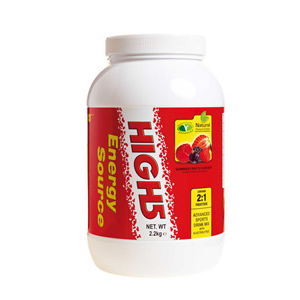High5 Energy Source Review
Energy Source is from British based company High5 Sports Nutrition. This supplement states that it helps maintain hydration during exercise and sustain performance during endurance events. This review will examine the ingredients within this supplement to understand how it can achieve this.
Ingredients
Maltodextrin
Maltodextrin is a polysaccharide which is a complex carbohydrate. This ingredient is water soluble and unlike other carbohydrates, is easily digestible (1) and can give a quick release of energy without any spikes of glycaemia (2).
Fructose
Fructose is a simple carbohydrate and is an intermediary in the metabolism of glucose (3). It has a low caloric value, low glycemic index (4) and gives a sweeter taste (5).
Citric Acid
The main function of citric acid is the reduction of physical fatigue (6). The reason for this is due to citric acid being a major component of the tricarboxylic acid (TCA) cycle. TCA cycle is the process of converting carbohydrates, fats and proteins into carbon dioxide and water (7). By increasing citric acid it activates the TCA cycle and in turn speeds up ATP production thus replenishing energy.
Malic Acid
Malic Acid is an organic compound that is naturally created within the body. The benefits of this ingredient have been suggested to include a lowering in blood pressure, helping against pre – exhaustion which will prolong exercise and reduce fatigue. There is a lack of research for this ingredient and more is needed to fully understand the benefits of this ingredients.
Sodium Citrate
Sodium Citrate is the sodium salt of citric acid. The benefits of this ingredient that have been observed are mainly for short term high intensity exercise (8). During high intensity exercise performance is limited due to an increase of pH within the muscle and the bodies inability to counteract this from buffering systems (9). Sodium Citrate can help aid this by helping to neutralize and offset these hydrogen ions and decreasing the pH level, this means that the body can perform short term, high – intensity exercise for longer periods of time (10).
Potassium Citrate
Potassium citrate is a form of potassium which has several function such as regulating water balance (11), central nervous system function (12) and helps convert glucose into glycogen which provides energy to the bodies muscles (13).
Salt
Sodium chloride is otherwise known as salt. It is theorised that sodium chloride can help prevent cramps as the key mechanism in muscle contraction is the flooding of the action potential in the muscle membrane, and so if there is a sodium deficiency it may cause the muscle to cramp (14).
Summary
Energy Source can achieve the claims that are made if taken at the correct times during performance. The carbohydrates that are in this drink can give vital energy needed during an endurance event or prolonged exercise session, with the addition of citric acid as well it can help reduce fatigue. It is recommended to consume this drink during workout. This supplement has no banned substances when referring to the WADA prohibited list when observing the label / ingredients posted on the website.
*NOTE – This product has not been tested in a laboratory and may contain other substances that may not appear on the label
References
1 – Haralampu, S. G. (2000). Resistant starch—a review of the physical properties and biological impact of RS< sub> 3. Carbohydrate polymers, 41(3), 285-292.
2 – Roberts, M., Lockwood, C., Dalbo, V. J., Tucker, P., Frye, A., Polk, R., … & Kerksick, C. (2009). Ingestion of a high molecular weight modified waxy maize starch alters metabolic responses to prolonged exercise in trained cyclists. In FASEB abstract.
3 – Racker, E. (2009). Alternate pathways of glucose and fructose metabolism.Advances in Enzymology and Related Areas of Molecular Biology, 15, 141.
4 – White, J. S. (2008). Straight talk about high-fructose corn syrup: what it is and what it ain’t. The American journal of clinical nutrition, 88(6), 1716S-1721S.
5 – Kyriazis, G. A., Soundarapandian, M. M., & Tyrberg, B. (2012). Sweet taste receptor signaling in beta cells mediates fructose-induced potentiation of glucose-stimulated insulin secretion. Proceedings of the National Academy of Sciences, 109(8), E524-E532.
6 – Sugino, T., Aoyagi, S., Shirai, T., Kajimoto, Y., & Kajimoto, O. (2007). Effects of citric acid and L-carnitine on physical fatigue. Journal of clinical biochemistry and nutrition, 41(3), 224.
7 – Baldwin, J. E., & Krebs, H. (1981). The evolution of metabolic cycles.
8 – Parry-Billings, M., & MacLaren, D. P. M. (1986). The effect of sodium bicarbonate and sodium citrate ingestion on anaerobic power during intermittent exercise. European journal of applied physiology and occupational physiology,55(5), 524-529.
9 – Oöpik, V., Saaremets, I., Medijainen, L., Karelson, K., Janson, T., & Timpmann, S. (2003). Effects of sodium citrate ingestion before exercise on endurance performance in well trained college runners. British journal of sports medicine, 37(6), 485-489.
10 – McNaughton, L., Backx, K., Palmer, G., & Strange, N. (1999). Effects of chronic bicarbonate ingestion on the performance of high-intensity work.European journal of applied physiology and occupational physiology, 80(4), 333-336.
11 – Lemann Jr, J., Pleuss, J. A., Gray, R. W., & Hoffmann, R. G. (1991). Potassium administration increases and potassium deprivation reduces urinary calcium excretion in healthy adults. Kidney Int, 39(5), 973-983.
12 – Goto, A. T. S. U. O., Tobian, L., & Iwai, J. (1981). Potassium feeding reduces hyperactive central nervous system pressor responses in Dahl salt-sensitive rats. Hypertension, 3(3 Pt 2), I128.
13 – Brady, R. O., Mamoon, A. M., & Stadtman, E. R. (1956). The effects of citrate and coenzyme A on fatty acid metabolism. Journal of Biological Chemistry,222(2), 795-802.
14 – McCance, R. A. (1936). Experimental sodium chloride deficiency in man.Proceedings of the Royal Society of London. Series B, Biological Sciences,119(814), 245-268.

| Use for | Endurance |
| Website | www.highfive.co.uk |
| Price | £12.99 – 30.99 |




